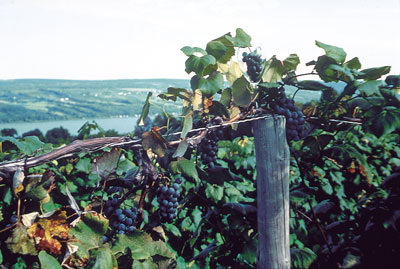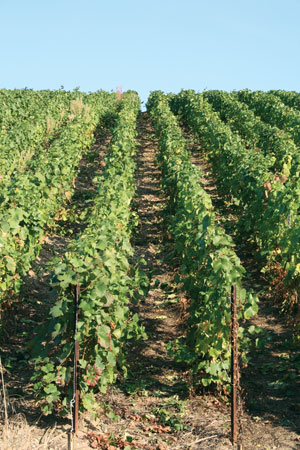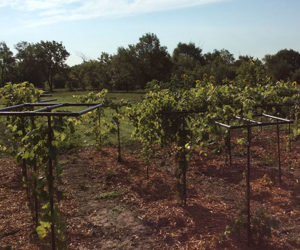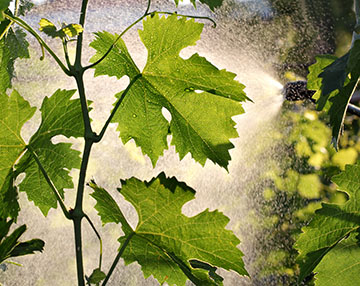Planting a home vineyard is a serious project that requires study, planning, a willingness to do agricultural labor and perhaps a small streak of insanity that comes with reaching a certain level of wine appreciation.
In planning your vineyard, there are lots of considerations. The purpose of this article is to introduce these issues to you, teach you some concepts, and then turn you loose to do your own research. It’s vital to network with other grape growers in your area to benefit from their mistakes and successes. Local wine growers can point you toward vineyard hardware suppliers, good nursery materials, help you choose your vineyard plot, your grape varieties and root stock. They might even help with the labor if you bring them enough wine. Most viticulturists I’ve interviewed admit that they would have planned and planted differently if they would have taken more time to read, network and plan. Once the vines are in the ground, there’s little you can do to change the basic layout of the field. With that understood, let’s start planning your vineyard.
Select Your Site
In the average backyard vineyard, there is little choice in your site selection. There’s a small piece of dirt that is unused, and that’s where we plant the vines. Do consider what a vine needs to grow sound fruit: good sunlight without excessive shade.
So growing grapes against a solid fence or a wall may be a bad idea. Remember what Galileo said, “Wine is sunlight, held together by water.”
Hillside vs. Flat
Hillsides, especially southwest facing hillsides in the northern hemisphere, have always been the preferred location for growing quality winegrapes. Hillside sites are generally well drained and have less frost issues in spring, as long as the cold air has space to flow down into. Consider the difficulties in farming on a hillside, though. Tractors and equipment take a beating. One has limited choices concerning row direction and row spacing — the slope, exposure and the topography will dictate where you can fit the vineyard. Terracing might be necessary, which can add thousands of dollars per acre to the establishment cost. Our vineyard is mostly hillside, and I deal with erosion and equipment difficulties constantly. There are few sights as inspiring to the wine lover as a hillside vineyard, but putting a vineyard on a slope will nearly double the effort required to maintain it, and will significantly increase the investment needed to establish it. Quality fruit can be grown on flat ground, it just tends to be a little more vigorous and might require some more vine-hedging.
Exposure
It is imperative to know what sections of your property get the most sunshine, wind, and shade throughout the growing season — roughly March to October in the US. Sun exposure on the fruit is key to getting good flavor out of your grapes, so planting a vineyard among shade trees or in the shadow of a canyon is not advisable. An open, sunny, southwest facing slope is perfect. Finding the spot on your property that gets early morning sunlight, and keeps that exposure until late into the afternoon will ensure that the vines get all the sun they need to grow, stay healthy and make sugar in the grapes. Some wind will protect the grapes against mold and mildew. Too much wind will shut the stomata on the leaves and cause the vine to shut down (stop respiring) temporarily.
Prepping the Soil
Follow these five steps to preparing the soil for a vineyard:
1. Evaluate the soil through test pits, soil samples and laboratory soil analysis. Get a USGS soil map and learn what “soil series” you will be planting on. Also learn how that soil series impacts agriculture. Dig a deep hole in the center of your vineyard site and take soil from the top 12” (30 cm), from between 12” and 24” (30–60 cm), and between 24” and 36” (60–90 cm). These are the depths that the vine will establish itself and grow most of its root structure. Collect a few pounds of soil from each depth in large ziplock bags and carefully label each bag by location and depth. Make sure to fill the pit back in so you don’t trap animals or careless children. Send the bags off to a good soil laboratory.
When you get the results back, the aspects of the soil should be described in context of “norms” for winegrape production. If the norms aren’t listed on the evaluation, you can call and yell at the lab, or hit the internet or library to find the normal ranges of nutrients for winegrape production.
You may also want to find out if there are nematodes or phylloxera in your soil. These are vine pests that can cause havoc if you don’t plant a vine rootstock that can resist them. Most soil labs can test a soil for these pests. Ask them about the best way to take a sample, or check their website.
2. Amend the soil with lime, nitrogen, compost, etc., to make it pH balanced and to add necessary nutrients as needed. Teach yourself a thing or two about what nutrients a vine needs, and then check your soil samples to see what needs to be added or amended. Take your soil samples to a respected company that sells amendments, and they will help you determine how many pounds or tons per acre of any given amendment your vineyard may need.
3. If your soil proves to be hard and compacted, and you can move equipment onto your property for the task, rip the soil to a three foot depth to help the vines establish strong, deep root systems. Do this after you have spread your amendments so they will be spread through the soil evenly. After ripping, disk the soil so it is uniform and relatively smooth.
4. Call a local farm supplier and let them know you need to grow some cover crop to keep your new ripped, disked vineyard site from eroding. A good cover crop — grasses, vetch, clover, etc. — will help slow erosion, add nutrients to the soil, attract beneficial insects and, if timed right, may even choke out potential weed growth. In areas with hard winters, growing a winter cover crop might not make sense.
Irrigation
Ask local winegrowers whether or not they use irrigation, or if the rainfall in your area is usually adequate to bring in a healthy crop. The natural habitat of Vitis vinifera gets around 30–50 inches (76–130 cm) of annual rainfall. Personally, I believe that an area that gets 30+ inches (76+ cm) of rain per year is appropriate for dry farming. Irrigation can be the most costly aspect of vineyard development. If you don’t need it, save the money. If it turns out you do need supplemental irrigation for your new vineyard, make sure to install it after ripping and disking, before planting cover crop and put in a system that takes elevation, gravity and water pressure into account. Most backyard vineyards are on flat ground. In this situation, and if the vineyard is less than 100 vines, you can hand water the vines with a hose, giving them enough water to grow every week or so. If you want a more elaborate drip system, this is yet another opportunity to bring a local winegrower a few bottles of wine. Ask how many gallons of water they apply per week in an average growing season, and how they apply it. You may need to set up a subsoil PVC system to get the water to the site, you may need to invest in a pump to keep pressure adequate, and if you are on a hillside you will need pressure compensating drip emitters, around 0.5 to 1.0 gallon (2–4 L) per hour. Without pressure compensating “drippers,” the vines at the bottom of the hill will get lots of water, and the vines at the top will get none due to increased gravity and pressure at the bottom of the system.
Trellising and Vine Spacing
At the risk of sounding like a broken record, you need to visit some local vineyards before deciding on a trellising system. If I learned anything at UC-Davis, it’s that viticulture is site specific. First, we need to understand how to decide on row and vine spacing, then we can come back and discuss trellising options a bit.
There’s no denying it. Vineyard spacing is a hot topic in wine-farming circles. The debate (deciding how much distance to put between individual vines and between vineyard rows) has become a high-interest issue with home viticulturists from the Carolinas to Malibu. There was a time when anything tighter than twelve feet (4 m) between rows and six feet (2 m) between plants was considered a high density planting. Indeed, many of the greatest vineyards in Napa Valley are still planted on this kind of wide spacing. But in the last two decades, and the last ten years specifically, high density plantings (spacing as close as 3 feet X 3 feet (1 m X 1 m) have become widespread. Even though squeezing thousands of vines into a one-acre planting seems a perfect strategy for a backyard vineyardist, there is plenty of evidence that high density vineyards can be extremely problematic on most soil types.
Viticulturists often express vine spacing with two measurements, such as “twelve-by-six” or “eight-by-four.” The first number represents the space between rows and dictates what kind of equipment is appropriate for the vineyard. Twelve-foot (4 m) row spacing will allow almost any kind of tractor, full-sized pickup truck, etc., to traverse the rows. Six to 8 foot (2–2.5 m) row spacing is generally the tightest that allows narrow tractors to work in the vineyard. One might be able to squeeze an ATV down 4 foot (1.2 m) rows, but take the rows to 3 feet (1 m) and get prepared to do all cultural practices by hand.
The second number expressed represents the distance between vine trunks. Together, these numbers will dictate vine density per acre. This will impact both yield per plant and yield per acre, and will also impact how the vines compete with each other for water and nutrients.
Now that you know how to express vine row spacing, the obvious question remains: how does an amateur viticulturist best match a potential home-vineyard site to a specific spacing arrangement? The answer is not necessarily complicated, but does require a good deal of thought, practice and planning. First let’s look at how vine spacing affects vineyard issues and wine quality, and then we’ll help you decide what spacing would be well-suited to your backyard vineyard.
If you remember anything from this article, remember this: Vineyards should be efficient to farm and vine spacing should be based on the anticipated vigor of the vineyard. The amount of work you will have to put into your vineyard is dictated by how well you match vine vigor to a trellising and spacing arrangement that harnesses that vigor into an appropriate “system.”
Let me give you an example. An acquaintance asked me to consult on a vineyard project gone wrong. This was the worst kind of consulting job — one where all the decisions had all been made — in an incorrect fashion. The vineyard owner had gone to Burgundy, France, saw beautiful Pinot Noir vines arranged in meter-by-meter fashion and decided that he wanted the same type of vineyard on a small one-acre slope at his home in the Santa Ynez Valley in California. Don’t let aesthetics drive a planting project, and never base your vineyard design on the vigor and climate of a site 6,000 miles away.
The soil of the Santa Ynez site was highly vigorous, nutrient rich and deep. The vines sprawled out with canes eight feet (~2.5 m) and longer, and the more the owner tried to hedge the vines, the more lateral shoots appeared and clogged up the fruiting zone. Those beautiful 3-foot (1 m) rows became an impenetrable jungle of shoots and foliage — you couldn’t work the vines without a machete, and you might imagine how difficult it was to get sun exposure on the fruit, let alone find the clusters when harvest time arrived. This vineyardist assumed that high-density planting reduces vigor significantly. Competition does exist between vines, but not at a rate that will turn a high-vigor site into an appropriate location for a meter-by-meter system. Bottom line — high density planting is only appropriate on low to medium-low vigor sites where shoots rarely grow more than 4–6 feet (~1–2 m) per season. Sites that are appropriate for low-vigor trellising, such as a system that uses vertical shoot positioning wires to direct all growth up and out of the way of the fruiting zone, is usually appropriate for high density planting. Medium to high vigor vineyard sites are much more efficient to farm with at least 8 feet (2.5 m) between rows (to allow a few feet for shoots sprawling and draping), and six feet (2 m) in between plants, in order to give each vine ample space to spread its foliage and ripen a crop-load.
Next, let’s consider the factors that determine vine row spacing.
Cultivar: Some grape varieties are more vigorous than others. Pinot Noir is generally less vigorous than Syrah or Grenache, so Pinot Noir is generally a better candidate for high density planting, and Rhône varietals are better suited on a wide-spacing arrangement, unless the site is extremely low vigor. Choosing the correct varietal to grow on your property is the most important decision you’ll make in the planning process. Once you have a good idea of two or three options for grape varieties for your backyard — try to choose the vines best suited for the climate and soil in your backyard, and never choose a grape simply by what you like to drink. Start with this question: what varietal is the best wine grown and made within 100 miles (160 km) of your house?
Rootstock: Check with your grapevine nursery to see if they have rootstocks that can influence vigor to a level that will allow you to tweak your vine spacing to a specification that pleases you. Don’t expect miracles with rootstock either. They won’t guarantee low vigor. They have a small, but measurable effect on vine growth. There are high, medium and low vigor rootstocks, and choosing the right combination can save you lots of hedging or fertilizing later on. Careful research and pestering vine-growing neighbors about their spacing and rootstock combinations will likely steer you in the right direction. Rootstock will also help protect your vines against soil-borne pests.
Training-trellising system: As previously noted, low-vigor sites that are appropriate for vertical shoot positioning systems are usually more adaptable for higher density grapevines plantings. Head trained vines require even spacing that allows them to spread their shoots and not be crowded by their vine neighbors. Simple backyard trellising made of posts and wire should always allow as much space between the rows as the height measurement of an average vine in full growth. If you use fancy quadrilateral or split-canopy trellising, the rows have to give the vines ample room to grow and spread shoots to either side of the canopy. It should also be noted here that the closer the in-row vine spacing becomes, the less “wood” or buds should be retained at pruning for producing crop the following year. The main concern for the development of any vineyard should be designing a system that keeps canopy density at an optimal balance so there’s ample sun exposure on the fruit and in the area where buds determine the following year’s crop as a function of sun accumulation.
Fruit Shading: Shaded fruit has more problems with disease, mildew and rot and also accumulates less sugar, has higher pH, higher malic acid, less color and phenolic compounds and shows an increased vegetal/herbaceous character. Keep this in mind as we progress in our study of vine spacing, the main concern in developing vineyard spacing is to keep the fruit zone open to sun and air, eliminating cluster-shading leaves, lateral shoots, and over-cropped clusters that are all jumbled together. Smaller vines with increased sun exposure on clusters are often sought after by high-end winemakers, and the mythology of the high density European vineyards make this scenario even more attractive. Many winemakers admit that smaller vines with a light crop, in balance, produce high quality wine, and high density vineyard design, if used correctly, can increase vine competition and keep vine vigor slightly in check.
Soil depth, water availability and fertility: Deep, fertile soils with high macronutrient (NPK) levels will usually translate into high vigor vines that will require wider spacing. Low nitrogen levels in soil, soils that are rocky, shallow, have clay restrictive layers or are hillside oriented may have less vigor and may be more appropriate for tighter spacing. Remember that as planting density increases, the competition between vines will result in a measurable reduction of vigor. Competition between closely-planted vines is mainly for water. As such, supplemental irrigation is often required in high-density vineyards, especially near the end of the growing season. Remember that you can tweak the vigor of your site by judicious nitrogen applications to increase vigor, or by applying less water in the early season to decrease vigor.
Equipment available: If your tractor is six feet (1.8 m) wide, your rows should be at least 8–10 feet (2.4–3 m) wide. If you have an ATV with a little sprayer on the back, it should be able to fit comfortably down the row without running over errant shoots. If you have no equipment, your options are unlimited and you may want to pack some extra vines in to increase your land-use efficiency. First, determine your potential vigor by either planting a few vines near your house or in a garden, then determine your optimal spacing, then take into consideration what type of equipment you have or wish to purchase to make the farming easier.
Here are a few practical questions to ask yourself: How vigorous are grapevines in your specific soil, climate and area? In a highly vigorous vineyard with more than 10–12 feet (3–4 m) of shoot growth per year, vines should be spaced a minimum of 6–8 feet (2–2.5 m), and have rows as wide as the vines are tall. With 6–10 feet (2–3 m) of shoot growth a year, you should have 4–6 feet (1–2 m) between plants. Medium/low vigor sites, where vine shoots grow 4–6 (1–2 m) feet per year, may be appropriate for high density planting. Spacing between plants can easily be reduced to 3–4 feet (~1 m), and row spacing is more easily based on equipment needs and height of vines in the peak of the growing season. Remember: high density vineyards are generally trained lower, so they can still have a 1:1 ratio of vine height to row spacing for shading considerations.
How much time do you want to spend each week taking care of the vines? The more vines you have to prune, position, trellis, spray and tend, the more time-consuming your viticulture hobby will become. Carefully choose your vine-density to match vigor — but don’t lose sight of the responsibility that accompanies more vines per acre.
There is an interesting relationship between row and vine spacing. As row spacing decreases, so does yield per vine. As you might expect though, smaller row spacing increases tons per acre, so even though each vine is producing slightly less due to competition the yield is actually increased due to the fact that there’s more vines. In the correct climate and soil, high density planting can have a positive influence on vine balance, crop level and wine quality. Home viticulturists should be warned, though. Trying to imitate high-density plantings in your backyard may lead to more problems and poor wine quality. Choose a vine-spacing and trellising design that is suited for your own soil, vigor, varietal, rootstock, trellising and equipment and you will find that your planning will reduce future labor, provide higher quality fruit, and provide endless pleasure in the bottle and in the glass.
Planting Vines
After your trellising and irrigation are set up, you should be ready to plant some grapevines. Planting usually occurs in late spring after the threat of frost has passed. I suggest using dormant grapevines. My rates of success with dormant vines have proven significantly higher than using green-growing vines. If you receive your dormant vines from refrigerated storage, let them acclimate outside in the shade for about a week. Keep the vines moist and in the packing material until the morning of planting. At that time, fill a 5-gallon (19-L) bucket halfway with water, put the vines in root first, and carry the vines 20–40 at a time into the vineyard.
Dig a hole 18 to 20 inches (46–51 cm). Do not compact the soil on the sides of the hole. I know a few viticulturists that sprinkle broken shards of wine bottles in the hole before dropping the plant in, to keep gophers and burrowing pests from eating the roots. Some viticulturists also dip the roots in a solution of mycorrhizae fungus, which will increase the plant’s ability to uptake water and nutrients. Trim the root tips of the dormant vine and drop it in the hole, roots first. Make sure the graft union, which is the calloused bump where the rootstock meets the “scion” wood, is 4 to 6 inches (10–15 cm) above the final soil level. After the soil has been compacted and replaced, you need to dig up some extra, fluffy soil to mound over the exposed part of the vine. Pile the soft soil 1–2” (2.5–5 cm) over the part of the dormant vine sticking out of the ground. When you see substantial growth peeking out of the soil mound, gently remove the mound and allow the vine to grow as usual. Remove all the shoots but the strongest, and gently tie the growing shoot to the training stake with ½” (1.3 cm) green vinyl tie tape. Go through the vineyard every week or two and add green vinyl ties every 4–6” (10–15 cm) of new growth.
Your New Vineyard
If all went as planned, you should now have a thriving vineyard in your back- yard. The shoots are climbing, the green leaves are visible, and in a few years, you will start producing fruit.
Realize that this article is merely an overview of the issues of establishing and maintaining a vineyard. The more you research each element I’ve outlined here, the more successful your vineyard will be. Don’t forget to visit local vineyards and home growers, check the internet, join a few email groups or local clubs and do everything possible to gather information and professional support before ordering your vines. Every hour of preparation that goes into vineyard establishment will save hundreds of hours of hard labor in future seasons. Viticulture has been practiced for thousands of years. Your efforts and study will help preserve the tradition of growing grapes and making fine wine. When you have learned what it takes to grow good fruit in your neighborhood, make sure to share your expertise with other aspiring, local viticulturists. Share your wine and share your enthusiasm.









